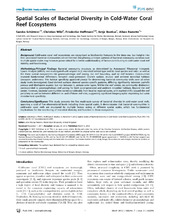| dc.description.abstract | Background: Cold-water coral reef ecosystems are recognized as biodiversity hotspots in the deep sea, but insights into their associated bacterial communities are still limited. Deciphering principle patterns of bacterial community variation over multiple spatial scales may however prove critical for a better understanding of factors contributing to cold-water coral reef stability and functioning. Methodology/Principal Findings: Bacterial community structure, as determined by Automated Ribosomal Intergenic Spacer Analysis (ARISA), was investigated with respect to (i) microbial habitat type and (ii) coral species and color, as well as the three spatial components (iii) geomorphologic reef zoning, (iv) reef boundary, and (v) reef location. Communities revealed fundamental differences between coral-generated (branch surface, mucus) and ambient microbial habitats (seawater, sediments). This habitat specificity appeared pivotal for determining bacterial community shifts over all other study levels investigated. Coral-derived surfaces showed species-specific patterns, differing significantly between Lophelia pertusa and Madrepora oculata, but not between L. pertusa color types. Within the reef center, no community distinction corresponded to geomorphologic reef zoning for both coral-generated and ambient microbial habitats. Beyond the reef center, however, bacterial communities varied considerably from local to regional scales, with marked shifts toward the reef periphery as well as between different in- and offshore reef sites, suggesting significant biogeographic imprinting but weak microbe-host specificity. Conclusions/Significance: This study presents the first multi-scale survey of bacterial diversity in cold-water coral reefs, spanning a total of five observational levels including three spatial scales. It demonstrates that bacterial communities in cold-water coral reefs are structured by multiple factors acting at different spatial scales, which has fundamental implications for the monitoring of microbial diversity and function in those ecosystems. | en_US |

